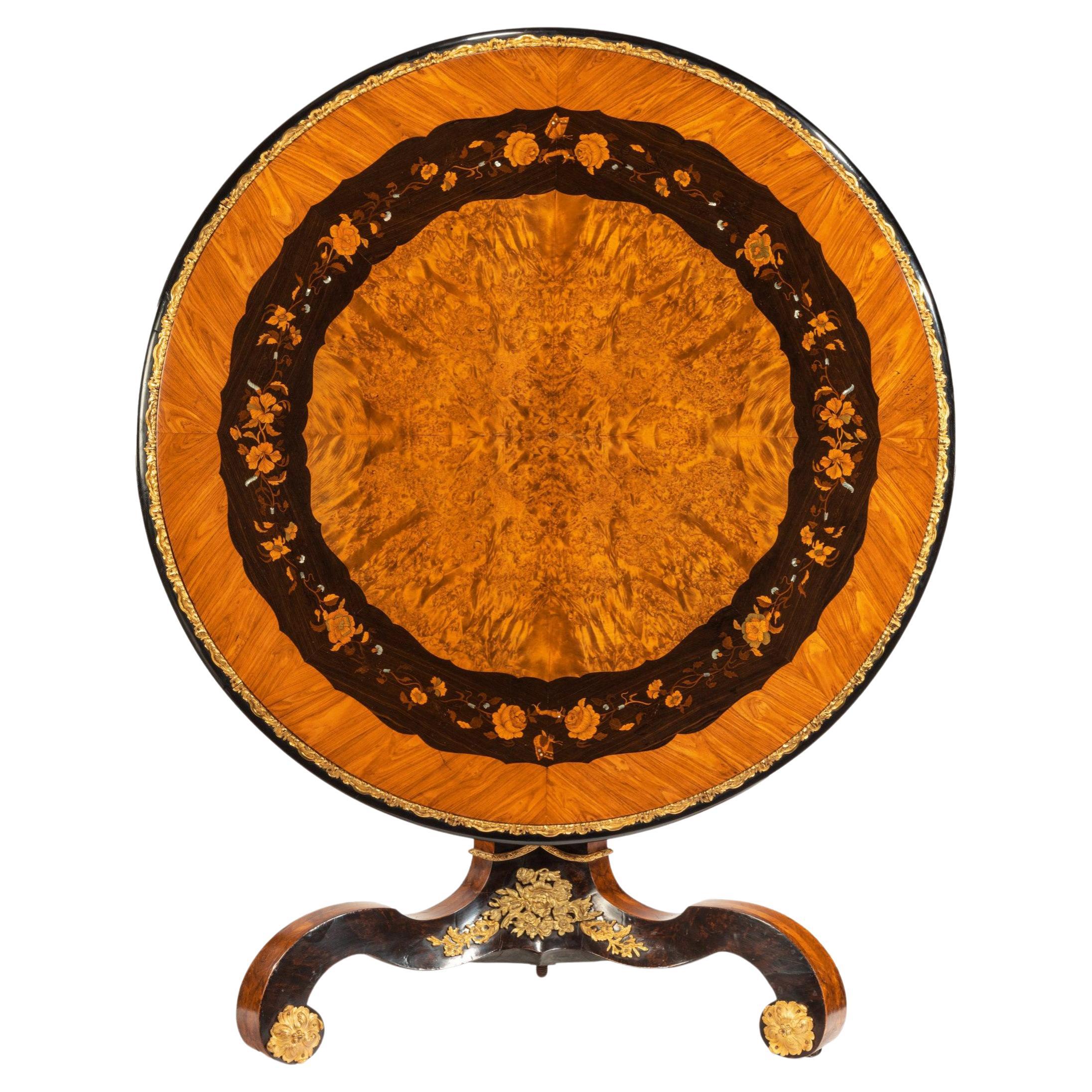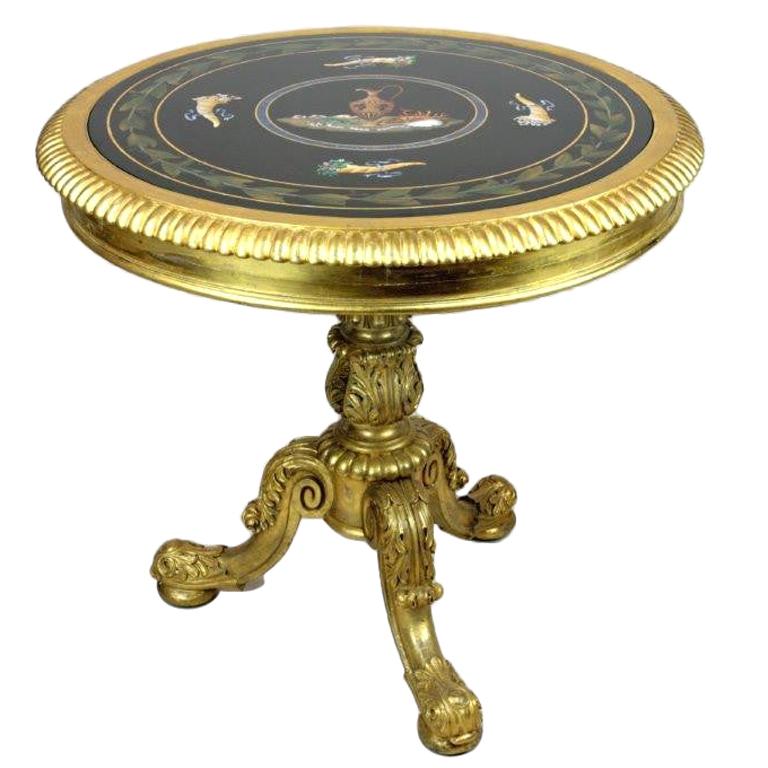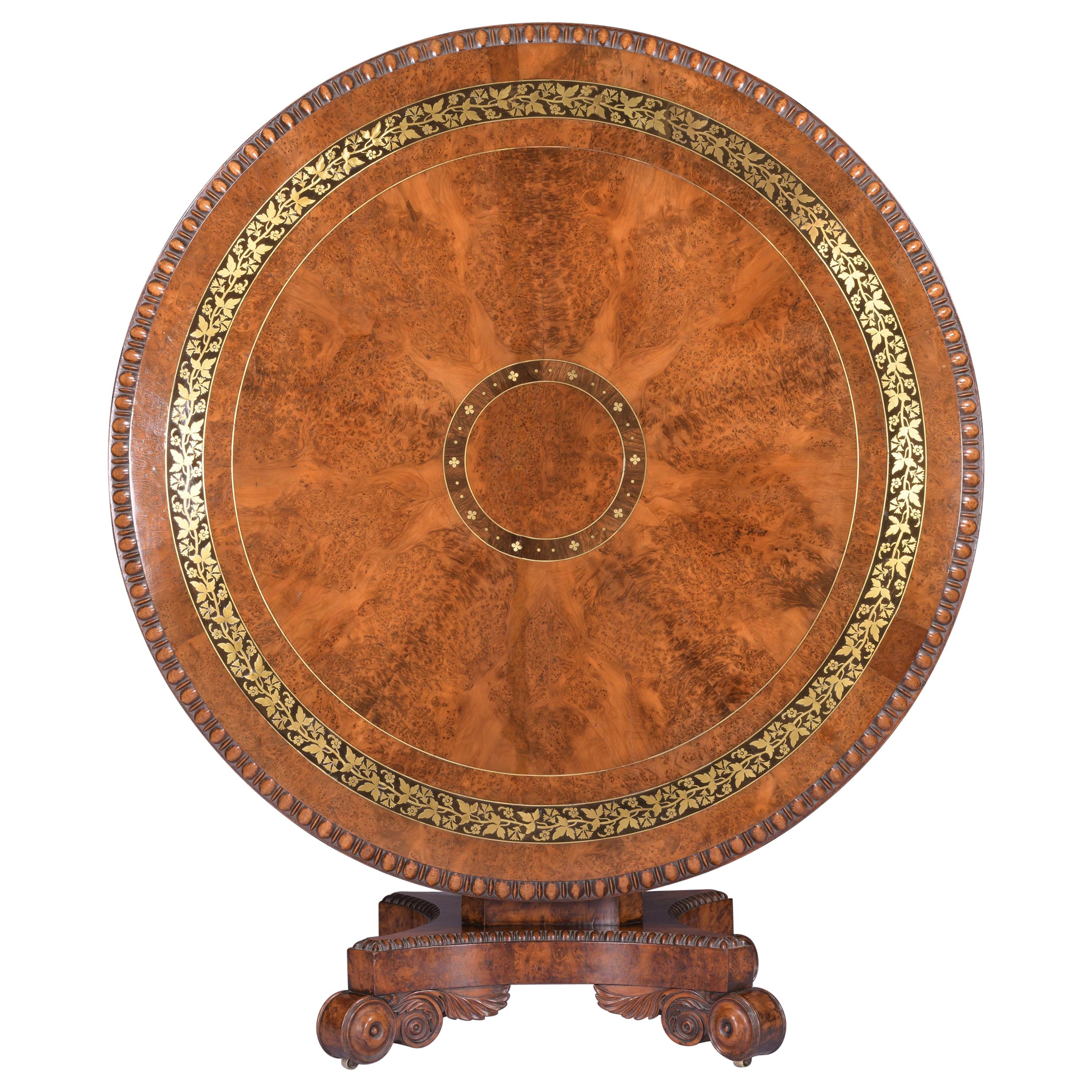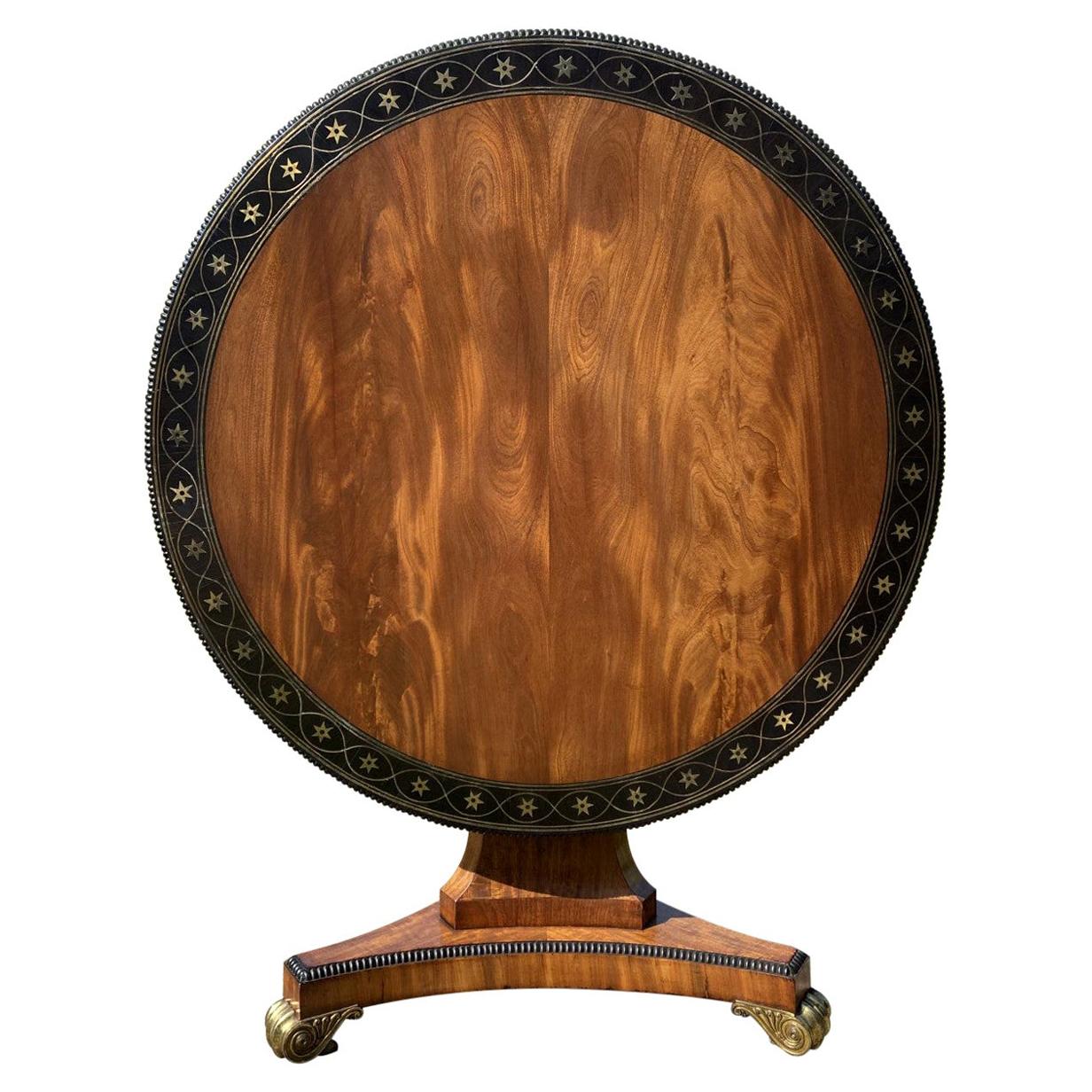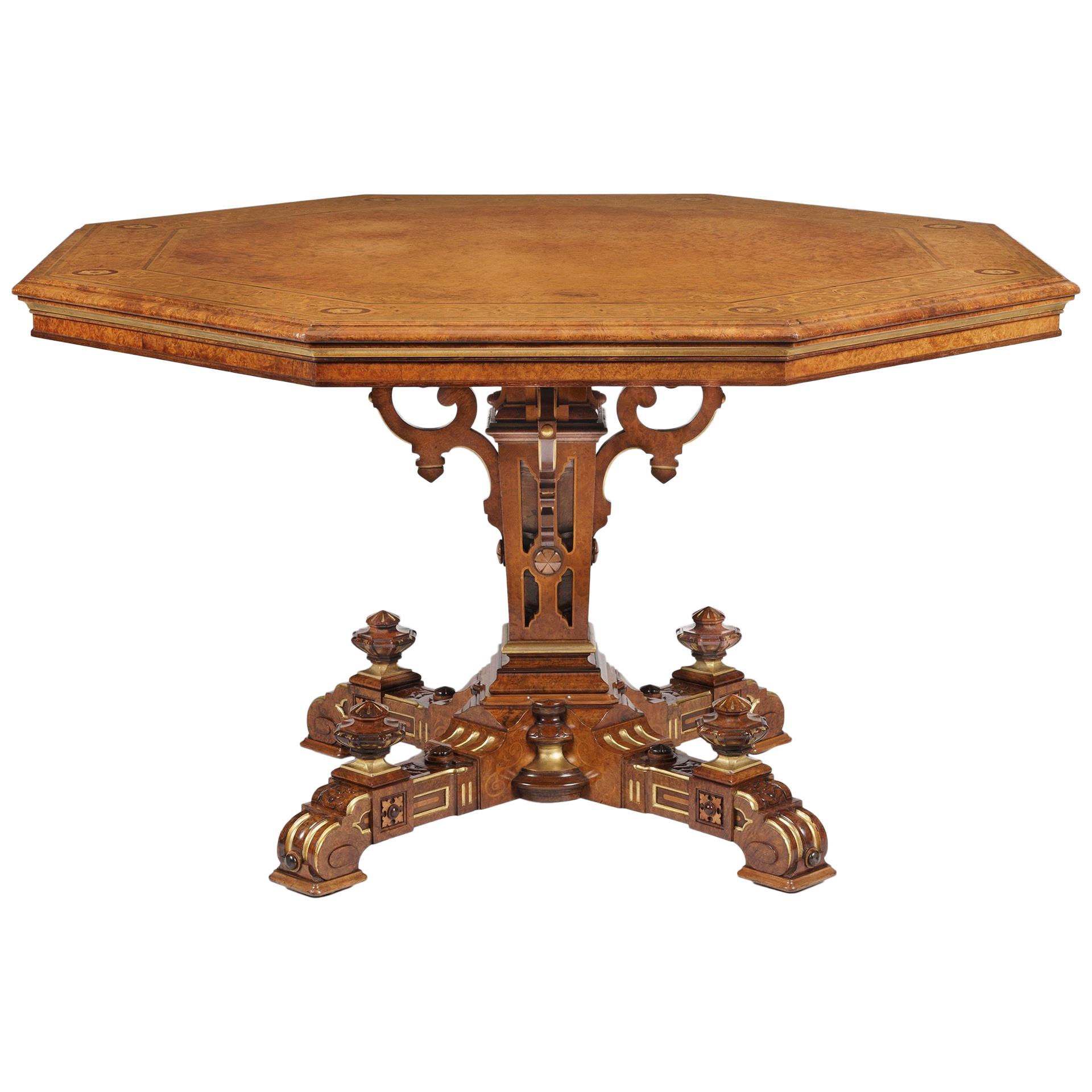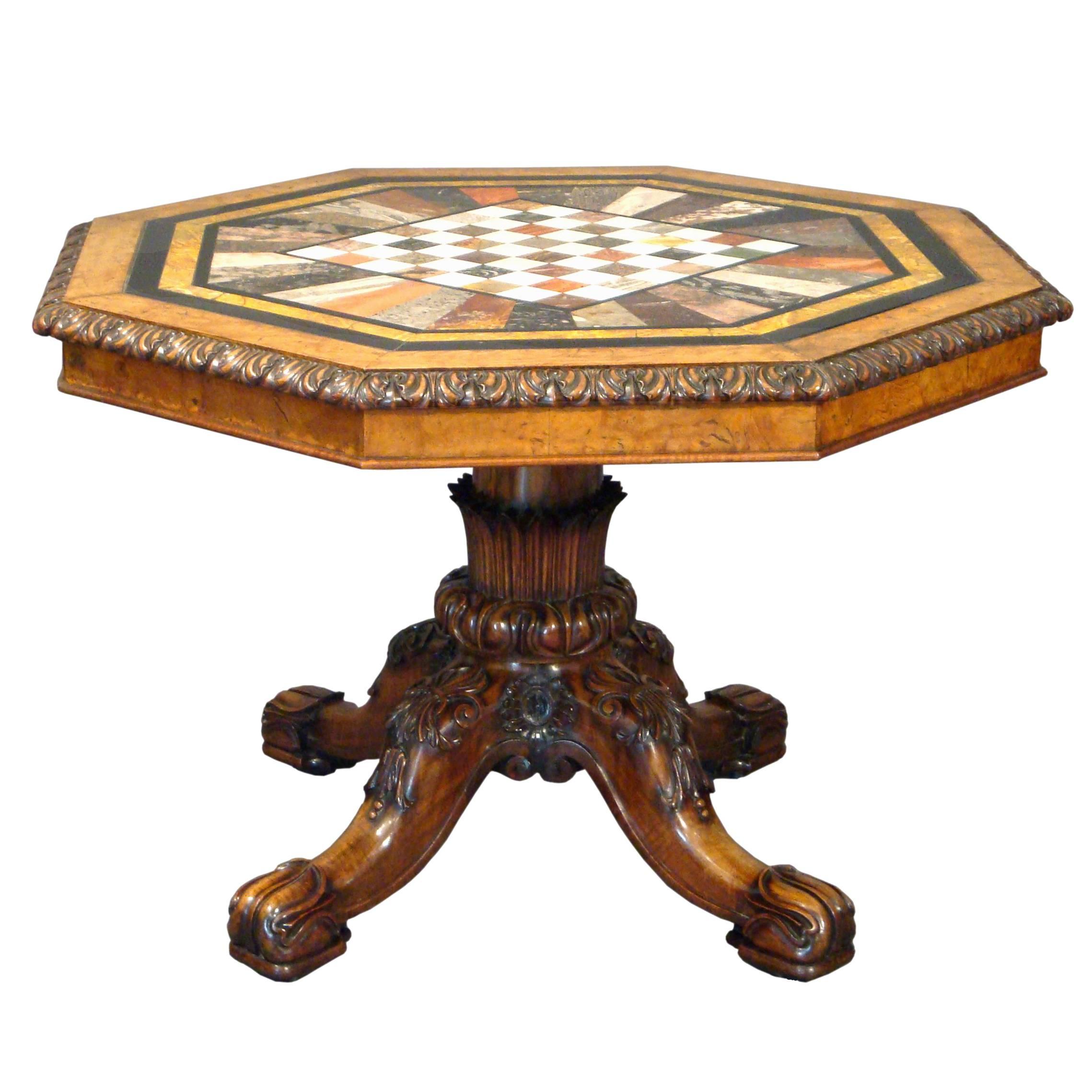Items Similar to Regency amboyna centre table, attr. to E H Baldock
Want more images or videos?
Request additional images or videos from the seller
1 of 5
Regency amboyna centre table, attr. to E H Baldock
About the Item
Late Regency Amboyna centre table, attributed to the workshop of Edward Holmes Baldock.
The circular top with a shaped apron set upon a solid triform base with powerful scroll feet, decorated with a central marquetry roundel of flowers and a butterfly in rosewood. stained boxwood, ebony, palm and ivory, within borders of scrolling acanthus. English c.1830
Footnote: Edward Holmes Baldock (1777-1845) was a prominent London furniture dealer to the Royal Family. He was listed in the London trade directories of 1821 as ‘an antique furniture and ornamental furniture dealer’ and in 1826 as a buyer and seller of ‘china, cabinets, screens, bronzes’ to patrons including William IV and Queen Victoria.
Provenance: With similarities to a centre table in the style of Baldock sold at Christie’s, 24th September 1987, lot 386. E.H. Baldock was fashionable London art dealer, furniture maker and restorer who traded from Hanway Street between 1805 and his retirement in 1843. See C. Gilbert ‘Furniture at Temple Newsam and Latheran Hall, 1978, Vol. II, no 395’.
The form of this table may have been inspired by a design in Richard Bridgens ‘Furniture with Candelabra, 1838’, for a ‘Marquetrie Centre Table’.
Ivory License Number: 52PWRERE
- Creator:Edward Holmes Baldock (Maker)
- Dimensions:Height: 28.75 in (73 cm)Diameter: 50.79 in (129 cm)
- Style:Regency (Of the Period)
- Materials and Techniques:Amboyna
- Place of Origin:England
- Period:1830-1839
- Date of Manufacture:1830
- Condition:Wear consistent with age and use.
- Seller Location:Lymington, GB
- Reference Number:1stDibs: LU973014978782
About the Seller
5.0
Recognized Seller
These prestigious sellers are industry leaders and represent the highest echelon for item quality and design.
Established in 1982
1stDibs seller since 2013
106 sales on 1stDibs
Typical response time: 2 hours
Associations
LAPADA - The Association of Arts & Antiques Dealers
- ShippingRetrieving quote...Ships From: Lymington, United Kingdom
- Return PolicyA return for this item may be initiated within 14 days of delivery.
More From This SellerView All
- Late Regency Giltwood Centre Table Attributed to GillowsBy Gillows of Lancaster & LondonLocated in Lymington, HampshireA very attractive antique late Regency giltwood centre table attributed to Gillow of Lancaster and London, inset with an Italian Pietra Dura top, The central turned baluster supp...Category
Antique Early 19th Century English Regency Center Tables
MaterialsGiltwood
- Regency Rosewood Five-Foot Tilt-Top Centre Table English, circa 1815Located in Lymington, HampshireA Regency rosewood five-foot tilt-top centre table, the circular top decorated with striking book veneers and a moulded edge, raised upon a stepped parcel gilt tripod...Category
Antique 1810s English Regency Center Tables
MaterialsRosewood
- Hungarian-Ash Centre Table Attributed to Holland and SonsLocated in Lymington, HampshireThis exhibition quality table is attributed to Holland and Sons. The octagonal top is supported by four turned knopped legs, all joint by a solid shaped stretcher centred on an urn. ...Category
Antique 1860s English Center Tables
MaterialsAsh
- Regency Rectangular Rosewood Tilt-Top Table Attributed to GillowsLocated in Lymington, HampshireA Regency rectangular rosewood tilt-top table attributed to Gillows, the rectangular top with bookmatched veneers set upon a shaped and reeded support with four splayed hip legs, Eng...Category
Antique 1810s English Tables
MaterialsRosewood
- Early Victorian Walnut Marquetry Centre TableBy Edward Holmes BaldockLocated in Lymington, HampshireAn early Victorian walnut marquetry centre table, attributed to Edward Holmes Baldock, of circular form with a superb quarter veneered burr waln...Category
Antique 1840s English Center Tables
MaterialsWalnut
- Fine Walnut and Burr Walnut Orientalist Centre Table, 1920Located in Lymington, HampshireA fine walnut and burr walnut orientalist centre table, of shaped rectangular form with a mirrored frieze, set upon carved cabriole legs terminating in acanthus feet, decorated with quarter veneered top inlaid in boxwood with scattered flower heads and butterflies centred on a spray of roses, each corner with a floral basket, framed within a raised border of boldly carved acanthus leaves and scrolls which continues around the frieze and onto the legs, the frieze further embellished with gilt brass Orientalist...Category
Vintage 1920s American Center Tables
MaterialsWalnut
You May Also Like
- Exceptional 19th Century Marquetry Centre Table, Edward Holmes BaldockBy Edward Holmes BaldockLocated in Benington, HertsAn exceptional marquetry and ormolu centre table of exhibition quality attributed to Edward Holmes Baldock. English, circa 1840. Finely co...Category
Antique Mid-19th Century British Early Victorian Center Tables
MaterialsEbony, Maple, Tulipwood
- English Regency Burr Yew Wood Centre Table Attributed To George BullockBy George BullockLocated in Dublin, IEAn exceptional Regency Burr Yew wood centre table attributed to George Bullock, the circular top having ebony strung segmented central panel and brass foliate scrolling floral marque...Category
Antique Early 19th Century English Regency Center Tables
MaterialsBrass
- Fine Regency Mahogany Library Centre TableLocated in Lymington, GBA fine Regency period tilt-top brass inlaid mahogany and calamander library center table. Raised on a concave-sided triform base, with well-modelled cast-brass scrolling feet. Also referred to as a monopodium (table). All in excellent condition, well figured, and of very good rich color. Typical of designs by Thomas Hope (1769 - 1831). This form of antique table is also associated with work by George Bullock (1777 - 1818) and George Oakley (circa 1765 - 1841). Refs: A similar table with a leather insert, in the manner of Thomas Hope, circa 1800 - 1805, was sold in London for £39,650 - December 2010. This early 19th century table is reminiscent of the ‘Grecian’ style that the pioneering collector and designer Thomas Hope (1769-1831) popularized in Britain with the publication of ‘Household Furniture and Interior Decoration’ in 1807. Thos. Hope (banker, born 1769, d. 1831) The furniture manufacturer George Oakley (circa 1765-1841) was greatly influenced by Hope’s designs, and produced fashionable furniture in this style, using brass and star inlays similar to our table on offer. The firm’s designs and craftsmanship earned them royal patronage, and Oakley worked for the Prince Regent at Carlton House, as well as supplying furniture and upholstery for The Mansion House and The Bank of England. His work for the Cheere family - of Papworth Hall, Cambridgeshire, UK - is well documented. The reference to Geo. Oakley relates to a known table of this pattern in calamander wood and brass marquetry of starred-ribbon guilloche, which corresponds to the brass marquetry in a table supplied by Oakley in 1810 to Papworth Hall. Lit: Parker, R. 'History of Papworth Everard...Category
Antique Early 1800s English Regency Center Tables
MaterialsMahogany
- Mid-19th Century Amboyna Octagonal Centre TableBy Johnstone, Jeanes & Co.Located in London, GBA good centre table by Johnstone & Jeanes of London Constructed in amboyna, with extensive marquetry inlays in specimen woods, and enhanced with parcel-gilt highlights. Rising from a cruciform platform base adorned with knops and having concealed castors, supporting the inlaid, and gently stepped and tapering centre column with stylized 'c' form brackets bracing the octagonal top, the outer guard band having English roses inlaid at the angles, with foliates with the national emblems of Scotland and Ireland, thistles and shamrocks. Stamped by the makers to the underside, 'Johnstone & Jeanes 67 Bond Street'. circa 1845 Published in “British Furniture 1820 to 1920” by Christopher Payne, 2023, p. 131, illustrated fig. 3.21. Johnstone, Jeanes & Co John Johnstone of Bond Street came to prominence after his collaboration with Robert Jupe, an 'upholder' of 47 Welbeck Street, Cavendish Square, London, who patented a remarkable design for a circular expanding dining table with a segmented top in 1835. After Jupe's death, the firm traded as 'Johnstone and Jeanes' from 1842 until 1880, having moved to 67 Bond Street and continuing the tradition of producing high quality furniture. After 1880, the company was re-named Johnstone & Norman. They exhibited at the Great Exhibition 1851, The International Exhibition of London in 1862, and The Paris Exhibition of 1878. Both the Royal Collection Trust and the Victoria & Albert Museum own stamped pieces of furniture in their collections. The company of Crace were designers and decorators to the Royal household from 1768 until 1899, working for every monarch from George the Third...Category
Antique Mid-19th Century English Center Tables
MaterialsAmboyna, Wood
- Exceptional Regency Walnut Centre Table with Specimen Marble TopLocated in Bradford-on-Avon, WiltshireAn exceptional Regency walnut centre table with a specimen marble top on a bold well-carved four-splay base; perhaps by Gillows of Lancaster.Category
Antique Early 19th Century English Regency Center Tables
MaterialsMarble
- Victorian Marquetry Tip-Top Center Table Attributed to Edward Holmes BaldockBy Edward Holmes BaldockLocated in Los Angeles, CAAn extraordinary fine English victorian marquetry Sycamore, Amboyna, burr-walnut and ormolu-mounted circular tulipwood crossbanding tip-top center table with inlaid decorations depicting wicker baskets full of flowers, vines, butterflies and hummingbirds, in the manner and attributed to Edward Holmes Baldock (1777-1845) after a design by Richard Bridgens, circa London, 1840. Measures: Height: 29 1/4 inches (74.3 cm). Diameter: 53 1/2 inches (135.9 cm). Edward Holmes Baldock (1777-1845) is listed in London Trade Directories of the period in various capacities. He first appears listed at 7 Hanway Street, London in 1805 described as a 'dealer in China and glass' and by 1821 as ' an antique furniture and ornamental furniture dealer'. By 1826 the various facets of the business included 'buying and selling, exchanging and valuing China, cabinets, screens, bronzes etc' Baldock's business seems to have largely involved trading in foreign items and from 1832-1837 he was the purveyor of earthenware and glass to William IV and later purveyor of china to Queen Victoria from 1838 until his death. He is known to have repaired, re-modelled and adapted furniture...Category
Antique 19th Century English Victorian Center Tables
MaterialsBronze
Recently Viewed
View AllMore Ways To Browse
Flower Center
Center And Hall Tables
Center Hall Table
E Table
Antique Table Makers
Centre Hall Tables
Centre Hall Table
Regency Bronze Table
England Sellers
Bronze Base Center Table
London Antique Dealers
Circular Centre Table
Ornamental Table
Antique Center Hall Table
Centre Table English
Antique Centre Table Designs
Antique Centre Table Design
Antique Ivory Table
